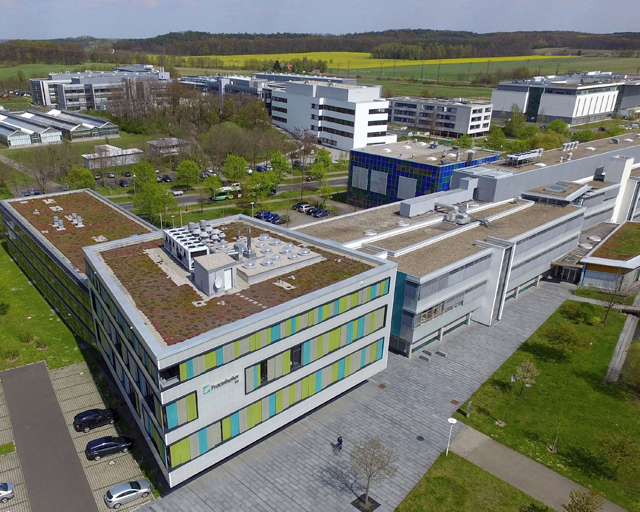25 years of the Fraunhofer IAP: Polymer know-how for the future
Since 1992 the Fraunhofer Institute for Applied Polymer Research IAP in Potsdam-Golm has been working with industry partners to advance polymer applications. One of 16 Fraunhofer Institutes, the IAP will present the highlights of its research work at an exhibition entitled "25 years of Fraunhofer in the New Federal States". It will be on display as part of the 2017 Annual Meeting of the Fraunhofer Institutes at the International Congress Center in Dresden from May 29 – 31.

The Fraunhofer IAP was founded in 1992 in Teltow-Seehof as one of nine new Fraunhofer Institutes and Institutions established in the course of Germany’s Reunification. Like most of these institutes/institutions, it emerged out of the GDR’s Academy of Sciences (ADW). Two Fraunhofer Institutes were established from the ADW’s Institute of Polymer Chemistry in Teltow-Seehof: the Fraunhofer IAP and the Fraunhofer Institutions for Polymeric Materials and Composites PYCO. Today they are reunited. PYCO, with its sites in Teltow and Wildau, became the Fraunhofer IAP’s sixth research division in January 2016.
"After the Reunification, the Fraunhofer Gesellschaft proceeded in an extremely goal-oriented way and was responsible for evaluating the application-related research of the ADW in the GDR. It quickly realized the enormous potential and know-how the Institute of Polymer Chemistry in Teltow-Seehof possessed", underscores Professor Alexander Böker. The chemist has been the head of the Fraunhofer IAP since 2015 and will launch the exhibition "25 years of Fraunhofer in the New Federal States" following the welcome speeches from the scientific, political and industrial sectors. "It is also remarkable how fair and open-minded Fraunhofer was back then when it came to East German research", praises Böker.
Significant expansion of the range of applications
In 2000 the Fraunhofer IAP moved from Teltow to its new building in the Science Park Potsdam-Golm. It had already begun focusing on polymers made from renewable raw materials such as cellulose, starch and polysaccharides, and on synthetic polymers. Since then its repertoire of research services and application fields has been considerably enhanced. With six research divisions, the IAP now has a range of proven expertise in various fields of application, such as fiber-reinforced bioplastics for lightweight engineering; printed organic electronics for displays, organic photovoltaics and security applications; microencapsulation to protect surfaces; and biocompatible materials for medical technology to name just a few. Newer fields of research include biotechnologically and chemically modified proteins and natural fibers, shape memory polymers, functionally integrated materials and biotech processes aimed at the efficient use of renewable raw materials like starch, cellulose and lignin.
Research and development on an industrial scale
In order to better meet the requirements of industry partners, a series of pilot plants at the Fraunhofer IAP enable processes to be scaled up to an industrial scale. All developments are tailored to specific applications.
A technical plant was established in the new building in Golm in which polymers are processed from a melt or a solution. Today high-tech wet and melt spinning systems enable high-performance fibers to be developed. Focus is also on developing carbon fibers. In addition, the Fraunhofer IAP has a mini plant for synthesizing polylactic acid.
2005 saw the grand opening of the Fraunhofer Pilot Plant Center for Polymer Synthesis and Processing PAZ in Schkopau, a joint initiative of the Fraunhofer Institute IAP in Potsdam-Golm and IMWS in Halle. The pilot plant center enables industry-relevant research on polymer synthesis and processing to be conducted on a ton scale.
In 2012 the "Application Center for Innovative Polymer Technologies" opened as part of the second expansion phase of the Fraunhofer IAP. A pilot plant for organic electronics allows for the manufacturing of larger sample series of flexible or rigid OLEDs and organic solar cells. Moreover, processes can be developed in a biotech pilot plant so that renewable raw materials, like starch, cellulose or lignin, can be more efficiently used in the future. Biopolymers can be biotechnologically obtained from the residuals of the agriculture and forestry industries with the help of newly developed enzyme systems.
The Processing Pilot Plant for Biopolymers Schwarzheide opened in 2013. It is also designed for industry-relevant scales with a focus on biopolymers that are processed into films. In the PYCO research division, highly crosslinked polymers are developed for industry partners and processed on an industrial scale using, for example, prepreg and coating machines.
Outlook: research for the future
"The next 25 years will see innovations in polymer research as a result of an increasing integration of disciplines such as physics, chemistry, biology, medicine, information technology and mechanical engineering. Combining these disciplines will create new materials that previously seemed impossible and unlock fully new application areas", explains Böker. In the recently inaugurated High Performance Center "Integration of Biological and Physical-Chemical Material Functions" researchers have already begun working on developing products that can be manufactured in the lowest number of process steps possible while still having the most technically relevant functions as possible.
Last modified:
